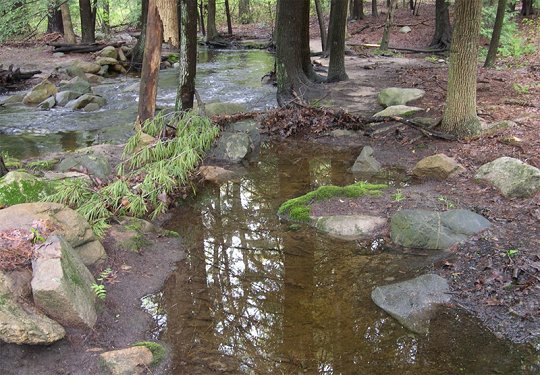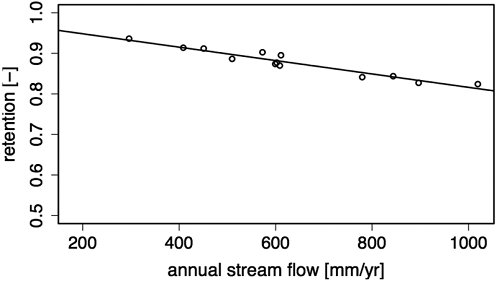
PIE-LTER
Site Resources:
Weather Station
(Field House Web Site)
Scale Matters
By conducting large scale, long-term studies of entire river-estuary networks, PIE scientists revealed ways that human activities and natural processes interact to control the flow of water and nutrients from the land to the ocean. This science helps to guide the reduction of harmful nitrogen pollution in coastal waters.
A myriad of human activities alter the hydrology and biogeochemistry of water running off from urban and suburban lands. PIE researchers have documented many of these effects, including an intensified storm response, greater annual runoff, increased nutrient loading, and reduced capacity for nutrient retention. These changes are most evident at the scale of small headwater streams. PIE researchers have also identified that while the effects of some of these changes are felt far downstream and into the estuary, natural processes can provide important services that lessen the negative effect. For example, during summers, nitrogen inputs are greatly elevated in small headwater streams that drain suburban areas. But as water flows downstream, microbes living in the water, stream bottom, and wetlands permanently remove much of this nitrogen as part of the natural process of denitrification. This greatly reduces the amount of nitrogen reaching estuaries and coastal ocean, particularly during the critical growing season. These findings suggest that land use policies that places development upstream of areas with high denitrification rates, including wetlands, streams, and floodplains, could help to prevent problems due to elevated nutrients such as coastal eutrophication and dead zones. Our findings also indicate that the effectiveness of this natural nitrogen removal process, while in general high, declines during wetter periods. This decline is caused by water flowing too swiftly through watershed ecosystems so that the microbes that denitrify don't have the chance to use all the nitrogen flowing by. As a result, increased climate variability and storm intensity could exacerbate increased anthropogenic nitrogen loading.
Example of storm event flood in a suburban headwater stream (Burlington MA), showing how storm flood waters go over bankfull, deposit sand, and scour the riparian zone clear of leaf litter. Peak storm flow had occurred prior this picture being taken (Wollheim photo).Humans themselves have also intentionally and unintentionally offset some of the extra nitrogen that they bring into the watershed via polluted air, fertilizers, and food (which potentially enters the system through human waste). First, much nitrogen is diverted before it ever gets to streams and rivers due to sewer system construction and treatment often distant from where it is produced, alleviating the need for local natural nitrogen removal. Second, humans inadvertently divert some nitrogen when they withdraw drinking water from larger rivers. Human engineered water transport often crosses basin boundaries, taking nitrogen with it. Both of these mechanisms have been documented by PIE researchers working in the suburban watersheds draining to Plum Island.
Long term data set of nitrogen exports from the watershed (1994-2009) compared to budget estimates of net inputs to the watershed indicate that more than 80% of estimated inputs are removed by watershed processes, but that this effectiveness declined in wetter years. (Wollheim et al. In Review; PIE-LTER database.)
Research at PIE provides a demonstration of the utility of long-term data sets for understanding human impacts on watershed and coastal ecosystems, and can reveal how the effects of human activity might be masked by other offsetting changes. In our study area, water withdrawals have increased considerably over the past 70 years. However, greater runoff due to increasing impervious surfaces and precipitation has also occurred over this time period, thereby offsetting increased water withdrawals. The net effect is that water reaching the coast has remained constant. Climate change in this case has proven beneficial to humans by delivering a greater amount of water for water supplies over an annual timescale. However, climate change has been unable to counter withdrawals during critical summer months, when downstream withdrawals overwhelm increased runoff due to impervious surfaces and climate change. Use of long term natural and human datasets are essential to evaluate the complex dynamics of changing climate, human activities, and natural ecosystem processes.
For further information: Wilfred Wollheim (wil.wollheim@unh.edu)
For further reading:
Claessens, L., C. Hopkinson, E. Rastetter, and J. Vallino. 2006. Effect of historical changes in land use and climate on the water budget of an urbanizing watershed. Water Resources Research 42:W03426.
Williams, M., C. H. Hopkinson, E. B. Rastetter, and J. Vallino. 2004. N budgets and aquatic uptake in the Ipswich R. basin, northeastern Massachusetts. Water Resource Research 40:W11201.
Wollheim, W. M., B. J. Peterson, C. J. Vorosmarty, C. Hopkinson, and S. A. Thomas. 2008. Dynamics of N removal over annual time scales in a suburban river network. Journal of Geophysical Research - Biogeosciences G03038, doi:10.1029/2007JG000660.

